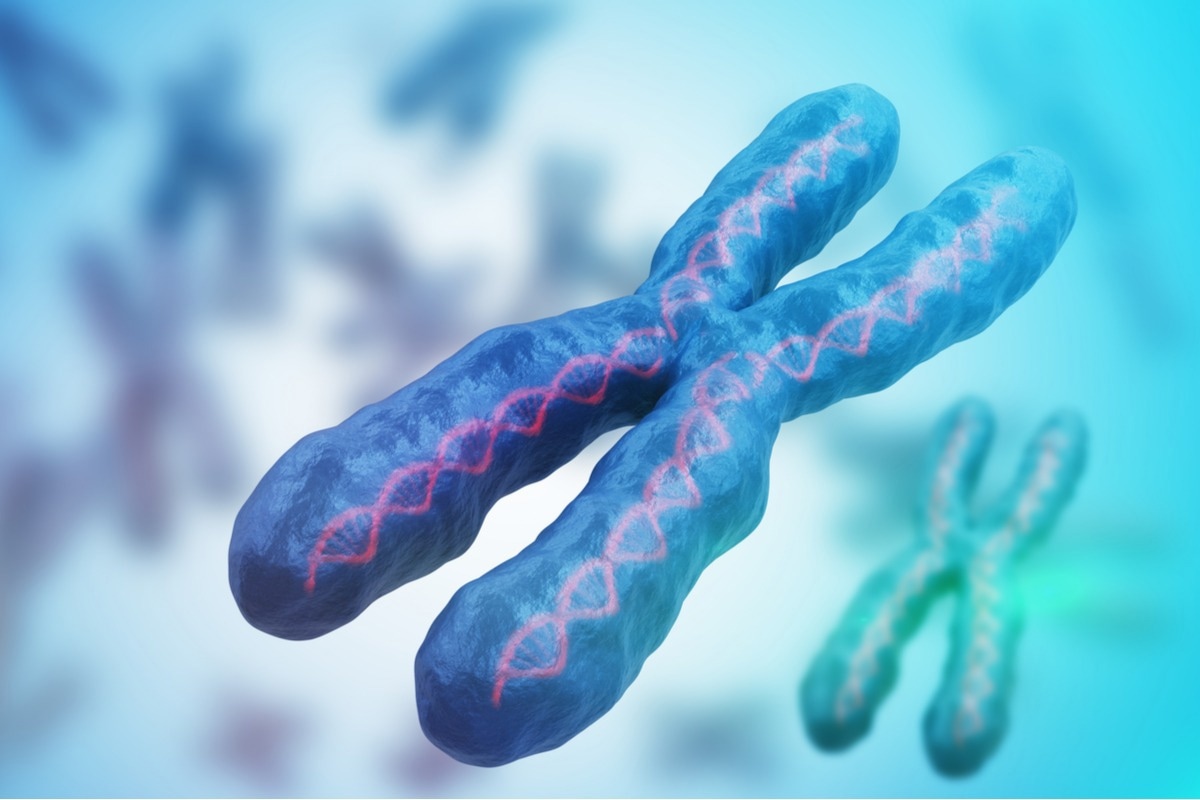Chromosome 2 is the second largest of the 46 chromosomes found in human cells. Chromosome 2 spans 243 million base pairs and makes up around 8% of the total DNA present within our cells. The base pairs are the DNA building blocks and are tightly packed, coiled, and supercoiled to form the structure of the DNA helix.

Image Credit: vchal/Shutterstock.com
Genetic research is focused on identifying the genes on our chromosomes and estimates suggest that chromosome 2 contains around 1490 genes. Several important diseases and conditions have been linked to gene abnormalities on chromosome 2, including maturity-onset diabetes of the young, primary pulmonary hypertension, and autism. Changes to the structure of a chromosome or abnormalities in the number of chromosomes present can also cause health conditions and some of these are described below.
- Changes in chromosome 2 have been shown to lead to several forms of cancer. The changes that occur are somatic, meaning they are acquired at some point throughout a person’s lifetime rather than being present when a child is born (as inherited changes are).
- One example of a chromosomal change that may cause cancer is the translocation (rearrangement) of genetic material between chromosome 2 and chromosome 3. This change has been associated with myeloid malignancies, cancers that involve a type of blood cell that is derived from the bone marrow.
- Trisomy 2 is a chromosomal abnormality, where human cells are found to contain an extra copy of chromosome 2. This is a rare but recurrent finding in myelodysplastic syndrome, a form of cancer caused by the bone marrow failing to produce enough healthy blood cells. More commonly, trisomy 2 is a feature of acute myeloid leukemia, along with other types of chromosomal abnormalities. Trisomy 2 has also been associated with hepatoblastoma, pleuropulmonary blastoma, and nasopharyngeal carcinoma.
- 2q37 deletion syndrome occurs when genetic material is deleted from a specific region of chromosome 2, near the end of the long arm at location 2q37. Symptoms of this condition vary between individuals but typically include short stature, intellectual disability, and autism.
- A ring chromosome refers to the formation of a circular chromosome when the ends of a chromosome break and join together. Individuals affected by the condition “ring chromosome 2” have delayed growth and development, a small head size (microcephaly), characteristic facial features, and heart defects. The severity of symptoms often depends on which types of cells are affected.
- Further examples of chromosomal 2 abnormalities include partial trisomy 2, where an additional piece of chromosome 2 is found in each cell, and partial monosomy 2, where a portion of the chromosome is missing. These structural abnormalities have various effects on the individual including delayed growth and development, impaired intellectual ability, distinctive facial characteristics, and weak muscle tone.
Within the primate family Hominidae, 24 pairs of chromosomes are seen in all species apart from humans and the extinct Neanderthals and Denisovan species, where 23 pairs of chromosomes make up the genome. One widely accepted theory is that chromosome 2 was formed by the fusion of two ancestral chromosomes. Supporting and even conclusive evidence exists for this theory. Firstly, the banding (staining pattern) of chromosome 2 in humans is closely matched to that of two different chromosomes in the chimpanzee, gorilla, and orangutan. Secondly, human chromosome 2 has the remnants of a second centromere (the point at which the two chromosomal strands are joined) instead of the usual one centromere. Finally, in humans, chromosome 2 telomeres are present at both the center and the ends, whereas usually telomeres are only found at the ends of a chromosome.
Chromosome 2 - What separates chimps from humans?
References
- IJdo, J. et al. (1991) "Origin of human chromosome 2: an ancestral telomere-telomere fusion.", Proceedings of the National Academy of Sciences, 88(20), pp. 9051-9055. doi: 10.1073/pnas.88.20.9051. https://www.ncbi.nlm.nih.gov/pmc/articles/PMC52649/#:~:text=We%20conclude%20that%20the%20locus,rise%20to%20human%20chromosome%202
- Family Cancer Syndromes (2022). Available at: https://www.cancer.org/healthy/cancer-causes/genetics/family-cancer-syndromes.html (Accessed: 30 June 2022).
- http://atlasgeneticsoncology.org/Anomalies/Tri2ID1429.html
- Myelodysplastic Syndromes Treatment (PDQ®)–Patient Version (2022). Available at: https://www.cancer.gov/types/myeloproliferative/patient/myelodysplastic-treatment-pdq#section/all (Accessed: 30 June 2022).
- mtDNA, C. (2018) Chromosome 2: MedlinePlus Genetics, Medlineplus.gov. Available at: https://medlineplus.gov/genetics/chromosome/2/ (Accessed: 30 June 2022).
- Evolution: Library: Human Chromosome 2 (2022). Available at: http://www.pbs.org/wgbh/evolution/library/07/3/l_073_47.html (Accessed: 30 June 2022).
Further Reading
Last Updated: Jun 30, 2022